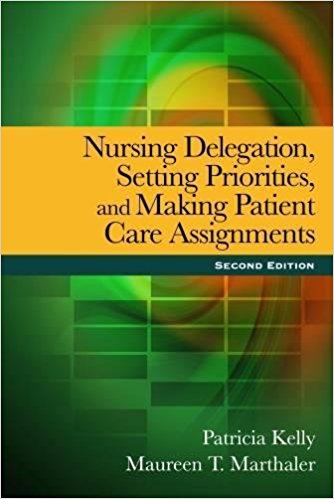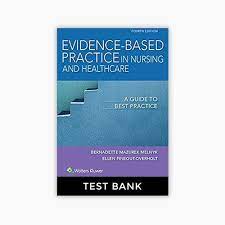
Test Bank For Nursing Delegation, Setting Priorities, And Making Patient Care Assignments 2nd Edition by Patricia Kelly
Original price was: $55.00.$20.00Current price is: $20.00.
Digital item No Waiting Time Instant DownloadISBN-10 : 143548178XISBN-13 : 978-1435481787
For nursing students and professionals wishing to improve their careers, we present the Test Bank For Nursing Delegation, Setting Priorities, And Making Patient Care Assignments, 2nd Edition by Patricia Kelly. This test bank should be beneficial to nursing students. To give it to the students, the creative solutions in this work are aimed at enhancing the understanding of concepts, which include nursing delegation, priority settings, and patient care assignments. With the help of our test bank, you can perform medicine effectively and properly before examination.
Why Other Nursing Test Sets Fail Our Students Trust Us?
Our test bank serves as a good complement to any studying nursing. It contains several practice questions that focus on nursing delegation and other topics covered in management. This is a good way to prepare for real-life situations. With this approach, all students feel very self-contained and self-confident before the exams. The ANA illustrates the development of Nursing Delegation, Setting Priorities, And Making Patient Care Assignments texts to make sure that all materials posted are relevant to what they study.
The Main Issues Addressed
- Delegation in Nursing: The section explains the principles relating to delegation in nursing practice, e.g., how to assign tasks to other members of the healthcare team. It covers the responsibility of nurses in delegating work and ensuring the safety of the patients.
- Setting Priorities: Be able to determine how to prioritize in the provision of patient care. This part of the test bank is concerned with establishing the most urgent activities that need to be done and how to perform them in the shortest time possible. It involves some style of strategies that assist in making and solving decisions in the clinical area.
- Patient Care Assignments: This section explains how to make patient care assignments. This part stresses the importance of the needs of the patients complimenting the skills of the health personnel. Sound assignments are critical elements in providing quality patient care.
- Leadership and Management: Identify and understand the role of leadership and management in nursing. This part of the test bank focuses on how a member of a healthcare team can effectively lead the team and be able to manage the medical care needed by the patients.
- Communication Skills: This section describes the role of communication in Nursing. This part explains how patients, their families, and other professionals involved in patient care can communicate effectively.
- Patient Safety and Quality Care: Explain the aspects of patient safety and quality of care. This part of the test bank stresses the importance of quality care and minimization of errors in patient contact.
- Ethical and legal aspects: Read about the ethics and legal issues in nursing practice. This segment deals with the issues of aspects of patients and the ethical obligations of nurses concerning their practice.
Advantages Of Our Test Bank
- Thematic Approach*: Our test bank contains questions touching all themes in the textbook. This ensures you are well prepared for any question that might be reserved for you during oral examinations.
- Range and Scope of Question Types; Multiple-choice, True-False, Short Answers, etc. This mix of question types enables you to familiarise yourself with various forms of questions thus increasing efficiency and efficacy in tests.
- Instant Results: You receive answers to your questions. This allows you to show your mistakes so that you know and understand what to correct and what the right answers are.
- Personalized Learning Plans: Employ the test bank for personal or group studies. No matter how you want to absorb information, individually or in a group, our test bank accommodates this.
Using the Test Bank Effectively
First, try to incorporate regular study sessions into your schedule and focus on particular topics to maximize the usefulness of our test bank. Use the questions as explanations by applying them to yourself to establish topics you have mastered and those that require additional reading. When using the test bank, the related textbook should also be used. Forming groups with classmates to work over difficult questions may be helpful too.
Conclusion
Purchasing our Test Bank For Nursing Delegation, Setting Priorities, And Making Patient Care Assignments, 2nd Edition by Patricia Kelly is the best decision for any nursing student. It equips all the necessary practice and preparation, needed to succeed in your examinations and future profession. Whenever you feel like there are challenges in your studies, just how about asking your nursing colleagues to join you? This makes it easier to study together as they have the same focus as one. I would encourage you to use this test bank now to start improving your academic performance. It is simply a reliable resource that you can use to help structure your study sessions.
Test Bank For Nursing Delegation, Setting Priorities And Making Patient Care Assignments 2nd Edition by Patricia Kelly.
Chapter 2: NCSBN Delegation Decision-Making Tree and the Five Rights
MULTIPLE CHOICE
1. The National Council of State Boards of Nursing (NCSBN) Delegation Decision-Making Tree consists of four steps. Which of the following is not one of these steps?
a.
assessment of the patient, staff, and situational context
b.
planning of the context based on the delegation needs
c.
surveillance, supervision, and monitoring of the delegation to ensure compliance with standards of practice, policy, and procedures
d.
evaluation and feedback to consider the effectiveness of the delegation
ANS: B
The National Council of State Boards of Nursing (NCSBN) developed a Delegation Decision-Making Tree as a means of providing consistent guidelines for nursing delegation of staff. The NCSBN Delegation Decision-Making Tree consists of four steps: 1) assessment of the patient, staff, and situational context, and planning of the delegation based upon the patient’s needs and resources available (not planning of the context based on the delegation needs); 2) communication with the delegate to provide direction and opportunities for interaction while the task is being completed; 3) surveillance, supervision, and monitoring of the delegation to assure compliance with standards of practice, policy, and procedures; and 4) evaluation and feedback to consider the effectiveness of the delegation.
PTS:1DIF:Comprehension
TOP: The National Council of State Boards of Nursing (NCSBN) Delegation Decision-Making Tree
2. A nurse who will be delegating some nursing tasks to other staff members has considered the client’s health care status and stability of condition, the predictability of risks and responses, the setting where the care occurs, and the complexity of the task being performed. Which of the four steps of the NCSBN Delegation Decision-Making Tree was used?
a.
assessment
b.
communication and planning
c.
surveillance and supervision
d.
evaluation and feedback
ANS: C
Step Three: Surveillance and supervision in the NCSBN Delegation Decision-Making Tree is related to the nurse’s responsibility for client care from a supervisory role. The nurse who operates in this stage considers the client’s health care status and stability of condition, predictability of risks and responses, setting where the care occurs, and complexity of the task being performed; determines the frequency of the supervision required; and is responsible for the timely intervention and follow-up based on problems and concerns (NCSBN, 1995).
PTS:1DIF:Application
TOP: The National Council of State Boards of Nursing (NCSBN) Delegation Decision-Making Tree
3. When a nurse decides to delegate a nursing task to others, several considerations take place before the decision itself is made. Which of the following is not one of these considerations?
a.
needs of the patient
b.
condition of the patient
c.
potential harm
d.
status of the staff
ANS: D
Decisions to delegate nursing tasks take into consideration several factors. Some of these include 1) the needs of the patient; 2) the condition of the patient; 3) potential harm; 4) the stability of the patient’s condition; 5) the task itself; 6) the ability to predict the outcome of the delegation; and 7) knowledge of the staff’s competencies and abilities.
PTS:1DIF:Comprehension
TOP: The Five Rights of Delegation
4. Education, training, utilization, and legal parameters for nurses are guided by several organizations and acts/laws. Which of the following is not one of these organizations or acts/laws?
a.
State Nurse Practice Act
b.
ANA
c.
TOM
d.
State Boards of Nursing
ANS: C
The scope of nursing practice, education, training, utilization, and legal parameters of nursing practice is guided and defined by several organizations and legal acts. Some of these include 1) the State Nurse Practice Act; 2) ANA; 3) NCSBN (not the IOM, which is the Institute of Medicine); and 4) State Boards of Nursing.
PTS: 1 DIF: Knowledge TOP: Regulations
5. Nursing tasks that can sometimes be delegated if the staff has received additional specialty training and credentialing are listed below. Which of the following is not correct?
a.
sterile procedures
b.
medication administration
c.
IV therapy
d.
health teaching
ANS: D
Some nursing tasks that are not commonly delegated can be delegated to staff members who have received specialty training and credentialing. Some of these tasks include 1) sterile procedures; 2) medication administration; 3) IV therapy; 4) care of broken skin and other minor cuts or abrasions; and 5) invasive procedures such as inserting tubes into body cavities and instilling substances via an indwelling tube. Tasks that cannot be delegated include: 1) health teaching; 2) planning of care; and 3) evaluation of care given.
PTS: 1 DIF: Knowledge TOP: Regulations
6. Organizations have certain responsibilities to their staff and employees. Some of these organizational responsibilities are listed below. Which of the following is not one of these organizational responsibilities regarding nursing staff?
a.
designing policies and procedures that are congruent with the State Nurse Practice Act
b.
documenting staff competencies for staff who provide direct patient care
c.
implementing a system that ensures ongoing education of only registered nurses to maintain their competencies
d.
allocating resources for adequate nurse staffing that allows the nurse to delegate appropriately
ANS: C
Organizations are responsible for providing an environment that is conducive to the determination and maintenance of competent staff and for effective nursing delegation. Some of these organizational responsibilities include: 1) designing policies and procedures that are congruent with the State Nurse Practice Act; 2) documenting staff competencies for staff who provide direct patient care; 3) implementing a system that ensures ongoing education of the staff (not only registered nurses) to maintain their competencies; and 4) allocating resources for adequate nurse staffing that allows the nurse to delegate appropriately (ANA and NCSBN, 2006).
PTS: 1 DIF: Comprehension TOP: Regulations






